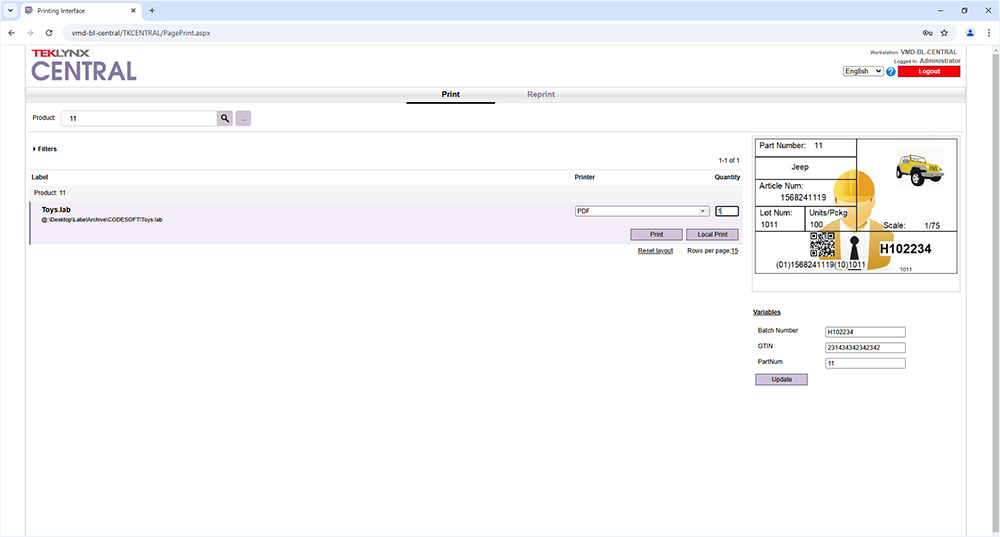Selecteer uw locatie en taal voor de beste website-ervaring

Companies with multiple locations have unique labeling challenges. When its locations are spread around the world, those challenges are magnified. Better connections are essential in a global labeling environment, so companies should consider how label management software can streamline operations and improve international connectivity.
Label management software is flexible and configurable to meet the labeling needs of global businesses that require security, efficiency, and accuracy in labeling. Continue reading and check out How to Integrate Labeling Software Across Multiple Locations to learn strategies for seamless global label management.
Companies with a single central location can enjoy the simplicity of a single network that serves the entire company. But global companies don’t have this luxury. Global IT teams manage a complex infrastructure of networks to make data and software available to the right people at the right time. Label management software alleviates this burden in three ways:
1. Browser-based printing interface: Print users access the label printing interface via a web browser (shown below), eliminating the need to install and manage software licenses on PCs located around the world. A lighter software footprint frees up resources to be used for other business needs.

2. Easy deployment and management of software: For users who need to design labels, the required software can be deployed from a central cloud-based administration command center. The label management infrastructure and database are securely hosted in the cloud, while label design software can be deployed to local print stations.
3. Cloud-enabled label management: Today’s label management solutions are cloud-ready, providing built-in flexibility and scalability for global companies. Not only can the software be installed in the cloud, but label files and label data can be accessed from the cloud using technology such as OData and RESTful API.
Companies with global footprints deal with labeling regulations that can vary country-by-country, not to mention export and import labeling requirements. Label management software gives global companies the tools to efficiently manage a variety of label templates and label printing rules.
4. Smart label templates: Global businesses already know the benefit of using label templates instead of individual label files. They’re already connecting database fields, using system date and time stamps, and may even be leveraging formulas to generate label data. Database connections can also be used to manage label translations or add legally required text to labels. Tools like VBScript take your labels to the next level by adding a layer of programming on top of the label to achieve your unique needs.
5. Label approval and version control: Compliance labeling is critical to get right, and mistakes can be costly. Global label management requires a strictly enforced label approval process. Using label security and traceability software, global companies can define their approval process, assign user roles, and maintain a record of every action taken. Version control allows you to easily roll back changes if necessary.
6. Electronic signatures: The label approval process can be configured to meet the needs of any global organization. For example, passwords can be required at each approval stage, meeting the need for electronic signatures required by labeling regulations such as the US FDA’s 21 CFR Part 11.
With multiple locations comes the challenge of working across multiple time zones. Time zone challenges can be both practical and technical.
7. Electronic label approval process leverages email: If your label designer works in California, but your regulatory expert for Europe lives in Germany, they share few working hours. By the time the label designer completes the draft of a new label, the approver is at home enjoying dinner. The electronic label approval process ensures that an email will be waiting in the approver’s inbox the next morning. The approver can also log into the label management system to view all their approval tasks in one place.
8. Respect for time zones: Sometimes, the server and client of a label management system reside in different time zones. This can cause glitches in the label approval process and prevent users from checking out approved labels. An effective global label management system converts all date and time stamps to Coordinated Universal Time (UTC) with offsets, enabling respect for all time zones.
Global companies tend to have more complex labeling processes, which increases the opportunity for errors. They also often have a high number of print users, and language barriers come into play across borders.
9. Label print automation: Label print automation software takes manual steps out of label printing. Using an existing business system (ERP, WMS, etc.), label print jobs are automatically triggered. The business system contains all the label data and generates a text file or database record that generates the print request. Automating label printing eliminates human interaction with the labeling process, greatly reducing the risk for labeling errors.
10. Simplified label printing interface: For many businesses, large portions of their labeling can be automated, but some processes still require a manual trigger. When a print user interacts with the labeling software, it should be as simple and straightforward as possible to reduce the risk of error and make their job quick and easy. Global companies may also face language barriers for their print users. Different language versions of the printing interface may be deployed, or the interface may be simplified to allow users to easily use it without language fluency. A simple click-and-print interface can be implemented for easy visual identification of labels.
MicroVention, a global medical device manufacturer, experienced rapid growth and had to re-evaluate their labeling process. Watch this short video to learn how MicroVention prints labels around the world securely, efficiently, and accurately.
Businesses around the world need a global label management solution to help overcome their unique labeling challenges and needs. TEKLYNX CENTRAL is built for just that and includes powerful features to serve companies in every industry. Request a demo to see how TEKLYNX CENTRAL label management software can streamline operations and improve international connectivity in your global labeling environment.
Doug Niemeyer is the President & General Manager at TEKLYNX Americas. He leverages his 25+ years of sales & marketing experience in technology and leadership to help grow the business. His passion for leadership, insatiable curiosity, and competitive spirit help to drive success, encourage progress and development while ensuring teams hold positive customer experiences in the highest regard, all with the purpose of helping companies barcode better. When he is not working you can find him in a gym, on a field or golf course playing or coaching.
Total Cost of Ownership (TCO) is a helpful concept for making business purchase decisions. TCO includes the upfront cost, related costs, and estimated ongoing related costs throughout the useful life of the purchase.
TCO is often compared to an iceberg because the obvious costs, like the tip of the iceberg, represent only a small portion of the total. Many costs are hidden beneath the surface, just like the true size of an iceberg is hidden underwater. A detailed TCO analysis can help reveal the full "iceberg," ensuring you're prepared for all costs—not just the obvious ones.
READ MORE
Labeling is a critical method of communication for any company with physical operations. If labels are wrong, it impacts so many other areas of the business: inventory, sales, customer relationships, quality assurance, regulatory compliance, and more. A label management system is an all-encompassing system that standardizes and centralizes the labeling process. With a successful label management system, labeling errors can be prevented, keeping your business efficient and productive.
READ MORE
Imagine you collect baseball cards. Maybe you started collecting when you were young, and you stashed your collection in a shoebox under your bed. As you grew older and your collection grew with you, you realized you needed to keep your collection more organized. The same concept applies to your labeling environment: growth requires systems!
READ MORE© Copyright 2025 TEKLYNX CORPORATION SAS. Alle rechten voorbehouden.
What do you think? Leave us a comment.
Comments will be reviewed and are subject to TEKLYNX’ comment policy. Your email address will not be published publicly.